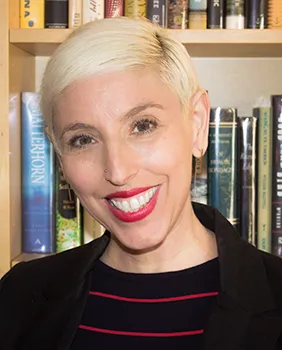- September 28, 2021
- By Chris Carroll
Washington, D.C., is often characterized as an impersonal machine of a metropolis that runs on the heady fuel of power rather than any discernible local culture—a place where residents camp out in expensive houses for the duration of a political administration before fleeing back to somewhere normal.

In her new book “Politics as Sound: The Washington, D.C., Hardcore Scene, 1978-1983,” due out next month from the University of Illinois Press, Shayna Maskell Ph.D. ’14 examines how a contingent of D.C. youth in the late 1970s and early 1980s reacted noisily to what’s true in the stereotype. But in giving the middle finger to government and corporate excess through music—spawning iconic bands still revered by a subculture of fans around the world—they also helped give the lie to the anti-D.C. caricature by creating an enduring piece of local culture to stand alongside Ben’s half smokes, lore from the glory days of the Senators and the old Uptown movie house—not to mention D.C.’s officially designated musical style, go-go.
Maskell, an American Studies graduate who is now an assistant professor in the School of Integrative Studies at George Mason University, recently zoomed with Maryland Today to talk about the capital city’s unofficial official musical genre, as well as the undercurrents—political, racial and gender-based—that fed into its eardrum shredding blasts.
Why do you focus specifically on those years?
You could have a debate about whether that was really the zenith of hardcore punk generally, because there were other scenes in other places or after that, but I think for anyone who experienced it in D.C. at that time, it would be hard to argue that it wasn’t. You had the rise of bands like Bad Brains and Minor Threat that that had an influence far beyond the D.C. hardcore scene, not to mention a lot of other significant bands. In terms of the amount of activity and number of bands and cohesive subculture that was formed, it was really the peak.
You focus more on scene and society than a musical analysis. What story are you trying to tell?
I grew up in Fairfax and still live around here, and I know there is this national idea of the area as simply a political bog. Then there’s the view of people who live in it, and I think hardcore music came from that dichotomy. There’s this notion of power and privilege and lawmakers doing their thing, and there’s the story of these young people who didn’t have any of that power or any of that privilege, but they did feel the effects of it. One way to react to that is with anger, which you hear in the music. So the takeaway is that hardcore offered a voice to those who felt they didn’t have one.
It’s always been mainly a white, male genre, yet when it arose, D.C. was a majority-Black city and the band that in many ways lit the hardcore fuse was a Black band.
It’s an interesting case. Bad Brains were the fathers—I guess 40 years later you could say grandfathers—of hardcore. They were incredible musicians at a time when punk was about “anyone can play,” and they built a following and influenced so many bands. They drew from jazz, so they were bringing this traditionally African American music that I think draws from a deeper Black collective musical experience into the genre of hardcore. But still, they became basically the only significant Black hardcore band in D.C. or nationwide.
Likewise, there have been relatively few female hardcore bands.
I’m teaching a class now on youth music and social change, and one of the things we’ve discussed is the sonic masculinity of punk—the loud electric guitars, the fast drumming, the yelling and screeching of the vocals. There’s nothing inherently male about any of it, but we’ve constructed it to have this kind of hypermasculinity. This is an important point when you’re examining the formation of outsider scenes like the D.C. hardcore scene. To obtain this kind of power, to obtain this kind of privilege, to record, to perform—it becomes a masculine-based power.
What’s the lingering legacy of those years? Is hardcore still around?
Sonically, you can trace how it evolved and kind of dispersed throughout the country in scenes that it would be hard to argue weren’t based somewhat on D.C.: in Boston, and New York and Austin. It evolved into post-hardcore and gave rise to alternative rock—you can see this evolution in a band like Hüsker Dü—and grunge (and not just because Dave Grohl was in an important D.C. band and went on to form Nirvana) and Riot Grrrl, which was hugely important for women regaining their agency in punk music.
Culturally, the “straight edge” movement [including avoiding smoking, alcohol and drugs, casual or exploitive sex and frequently, meat eating] that took hold in the D.C. hardcore scene became a hugely important subculture within a subculture nationally. It is still around; my sister-in-law still calls herself that.
Geographically, the scene gave D.C. a sound—in a different genre, it also has go-go of course—and an identity that people can still connect with. There’s a nostalgia factor. A friend who’s a tattoo artist told me Brian Baker of Minor Threat [which disbanded in 1983 in a symbolic end of the style’s early era] is coming in tomorrow. They all come in for a Minor Threat meeting once a year, and he comes to get a tattoo.
My husband and I argue about this quite a lot. He thinks it’s still alive. And sure, there are still hardcore bands going on in D.C., but what it lacks is the sense of community and structure, and of course, the production of music is far lower.
